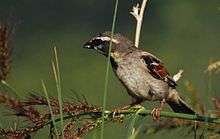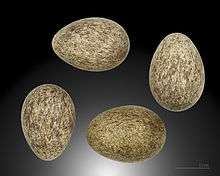Dead Sea sparrow
| Dead Sea sparrow | |
|---|---|
 | |
 | |
| Male (above) and female (below) in south-eastern Turkey | |
| Scientific classification | |
| Kingdom: | Animalia |
| Phylum: | Chordata |
| Class: | Aves |
| Order: | Passeriformes |
| Suborder: | Passeri |
| Infraorder: | Passerida |
| Superfamily: | Passeroidea |
| Family: | Passeridae |
| Genus: | Passer |
| Species: | P. moabiticus |
| Binomial name | |
| Passer moabiticus (Tristram, 1864) | |
| Synonyms | |
|
Passer mesopotamicus Zarudny, 1904 | |

The Dead Sea sparrow (Passer moabiticus) is a bird of the sparrow family Passeridae, with one subspecies breeding in parts of the Middle East and another in western Afghanistan and eastern Iran. The eastern subspecies P. m. yatii is sometimes considered a separate species Yate's sparrow.
Description
It is a small 12–13 cm long sparrow.
The male Dead Sea sparrow has a grey crown, rear neck and cheeks, and a small black bib. It has a pale supercilium shading to buff at the rear, and yellow neck sides. The upperparts are dark-streaked reddish brown, and the underparts are grey-white.
The female is like a small house sparrow, with a streaked brown back, greyish head and buff-white underparts. She is paler and smaller billed than the house sparrow, and sometimes shows yellow on the neck sides.
The eastern race P. m. yatii is sandier, and the male has a yellow wash to the underparts.
The chirping song resembles those of house and Spanish sparrows, but is softer. The flight call is a high-pitched chi-wit. This species is often silent.
Distribution and habitat
As its name suggests, is a breeding bird around the River Jordan, Dead Sea, and into Iraq, Iran and western Afghanistan. Breeding recorded in Cyprus in the 1980s but it may be extinct there now. This species is migratory or dispersive away from its breeding season. The eastern subspecies wintering in western Pakistan, but the regular wintering grounds of the western subspecies are largely unknown. Flocks of the nominate western race have been found in winter further south in the Middle East.
Behaviour
This species feeds principally on seeds, like other sparrows. It breeds in dry lowlands with some shrubs, including tamarisk, and access to water. It builds a nest in a tree, and four to seven eggs are laid.
References
- ↑ BirdLife International (2012). "Passer moabiticus". IUCN Red List of Threatened Species. Version 2013.2. International Union for Conservation of Nature. Retrieved 26 November 2013.
Works cited
- Clement, Peter; Harris, Alan; Davis, John (1993). Finches and Sparrows: an Identification Guide. Princeton, New Jersey: Princeton University Press. ISBN 0-691-03424-9.
- Summers-Smith, J. Denis (1988). The Sparrows. illustrated by Robert Gillmor. Calton, Staffs, England: T. & A. D. Poyser. ISBN 0-85661-048-8.
- Yom-Tov, Yoram; Ar, A (1980). "On the breeding ecology of the Dead Sea sparrow, Passer moabiticus". Israel Journal of Zoology. 29 (4): 171–187.
- Yom-Tov, Yoram (1980). "Intraspecific nest parasitism among dead sea sparrows Passer moabiticus". Ibis. 122 (2): 234–237. doi:10.1111/j.1474-919X.1980.tb02663.x.
- Yom-Tov, Y.; Ar, A.; Mendelssohn, H. (1978). "Incubation Behavior of the Dead Sea Sparrow". Condor. 80 (3): 340–343. doi:10.2307/1368046.
- Yosef, Reuven; Zduniak, Piotr; Tryjanowski, Piotr (2004). "Age, sex and season related biometrics of the Dead Sea Sparrow Passer moabiticus" (PDF). Ardeola. 51 (2): 297–302.
External links
 Media related to Passer moabiticus at Wikimedia Commons
Media related to Passer moabiticus at Wikimedia Commons- Dead Sea sparrow at the Internet Bird Collection
